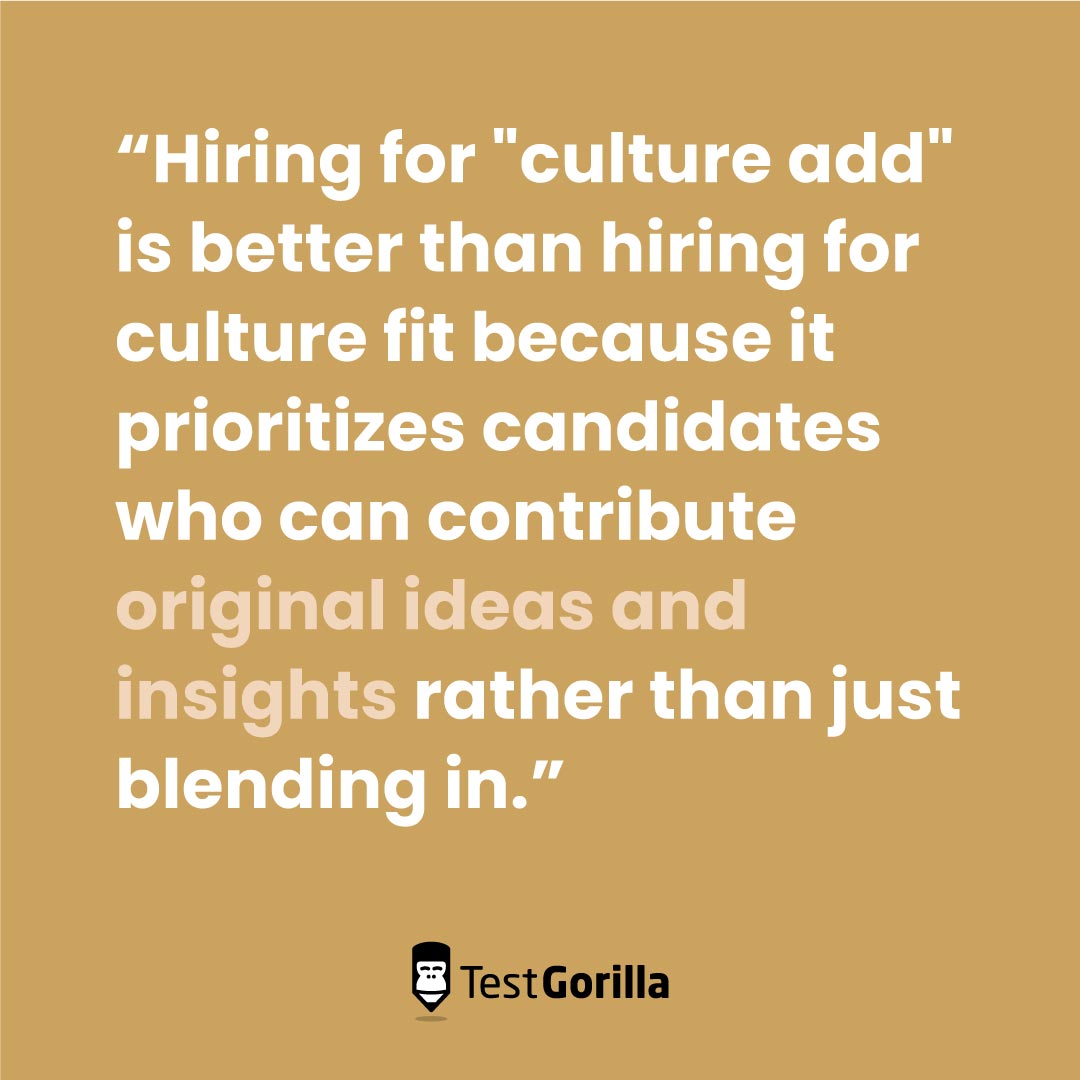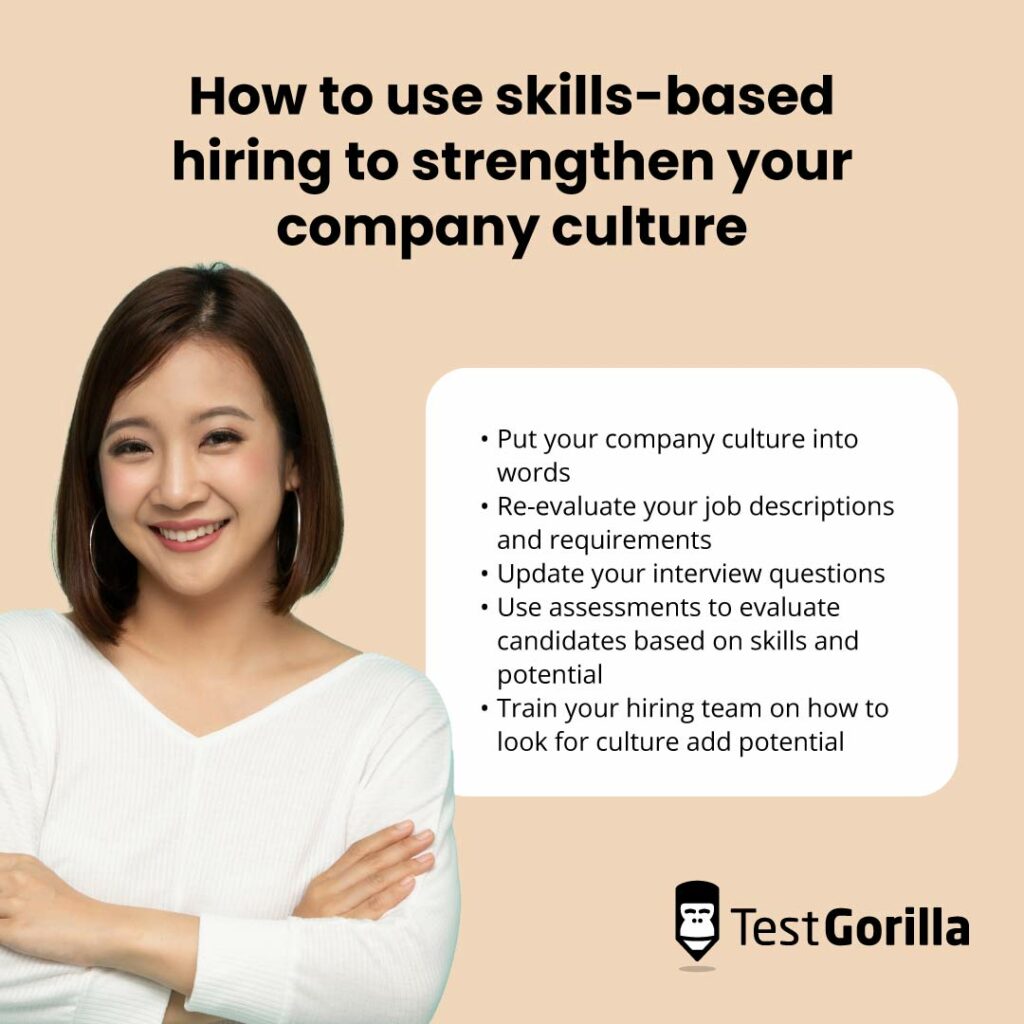Imagine trying to cook a meal using only two ingredients. Even if you manage to create something that’s technically edible, it will be bland, one-dimensional, and unsatisfying.
Hiring based on culture fit – choosing candidates with the same values, attitudes, and behaviors as existing employees – is like cooking with just two ingredients. You may end up with a functional team, but you’ll miss out on the depth and complexity that comes from incorporating different perspectives, experiences, and skills.
Instead of searching for candidates who fit a preconceived mold, you need to look for people who bring fresh viewpoints and unique backgrounds to your company culture. A skills-based hiring approach helps you identify these candidates and build a culture that embraces differences and seeks out new ideas.
Table of contents
Why is culture fit controversial?
The concept of culture fit is well-intentioned, but it’s one of the most exclusionary hiring practices in use today. Companies want their teams to be cohesive and productive, but when culture fit is used as the primary criteria for hiring, it can lead to a homogenous work environment. This approach becomes especially problematic when culture fit devolves into hiring based on personal preferences instead of focusing on a candidate’s strengths.
If your company only hires people who act and think the same way, you’ll end up with a workforce that lacks creativity and diversity. This sameness limits innovation and ultimately stifles your company’s potential for growth.
Hiring for culture fit can also be used as a cover for discrimination. If a company only employs people who look and act a certain way, it may exclude qualified candidates based on race, gender, or age. This approach makes a hiring practice unethical and can lead to legal trouble down the road.
Why hiring for culture add is a better bet
Hiring for “culture add” is better than hiring for culture fit because it prioritizes candidates who can contribute original ideas and insights rather than just blending in.
A culture add strategy focuses on hiring candidates who can add to your company’s culture through different perspectives, experiences, and skills rather than simply assimilating. Instead of hiring candidates who fit or blend in, you get people who add something valuable to the mix, like original insights, innovative ideas, and unique problem-solving approaches.
Hiring for culture add drives innovation and boosts financial outcomes. Research by Harvard Business Review found that cognitively diverse teams solve problems faster. Based on McKinsey data, companies with the most diversity also tend to perform better financially.
How skills-based hiring and culture add work together
Culture add is all about bringing in candidates who can enrich your company’s culture with their unique perspectives and experiences. But, to make sure they can contribute effectively, candidates should also have the right technical skill set for the job. That’s where skills-based hiring comes into play.
By focusing on a candidate’s expertise and know-how instead of just their resume or education, skills-based hiring helps you find people who, although they may not fit the traditional mold of an ideal candidate, actually have what it takes to thrive in their roles. On top of this, they bring something new to your company culture.
So, while culture add and skills-based hiring are distinct strategies, they work together to create a more diverse, inclusive, and effective workforce. Culture add ensures your team benefits from a range of perspectives, while skills-based hiring confirms that each team member has the right competencies for their role. When you combine these approaches, you create a well-rounded team that can drive innovation and growth.
To clarify the connection between the two, think of skills-based hiring as the foundation that supports culture add. By prioritizing skills and experience, you can reduce bias in the hiring process and create a more diverse and inclusive workforce. With this framework in place, you can then focus on finding candidates who will also contribute to your company’s culture in unique and valuable ways.
How to use skills-based hiring to strengthen your company culture
Integrating culture-add and skills-based hiring methods into your recruitment process is the best way to create a competitive workplace. Here are several effective ways to get started:
Put your company culture into words
To verify that your company’s beliefs resonate with prospective employees, you need to articulate your company culture in a way that goes beyond buzzwords.
Values are the pillars of culture. Take some time to explore the core values of your organization and make sure they are aligned with its mission and goals. A unified vision will foster a sense of purpose among your employees.
For example, if your company values collaboration and creativity, define what those values mean in practice. How do employees demonstrate collaboration and creativity on a day-to-day basis? How do those values relate to your company’s overall mission and goals?
Once your core values are defined, translate them into a clear, concise statement that communicates your organization’s guiding principles and expected behaviors. This declaration will attract candidates who will complement and enhance that culture.
Re-evaluate your job descriptions and requirements
Take a critical look at existing job descriptions and remove any unnecessary requirements that may exclude qualified candidates on the basis that they’re not a traditional “fit”. For instance, remove any specific educational background that’s not strictly necessary for the role and any technical skills or certification requirements that aren’t directly relevant to the job.
Once you’ve removed those unnecessary requirements, take another pass to eliminate non-inclusive language. Use gender-neutral terms and avoid using insider technical jargon, like acronyms that are uncommon outside your industry or the specific role.
Update your interview questions
When using skills-based hiring to build a more inclusive workplace culture, your interview questions should focus on relevant skills and experiences. Don’t ask generic questions about a candidate’s background – instead, gauge how they feel about your vision and your values.
We suggest using situational questions to uncover a candidate’s values and how they handle unique workplace situations. By asking your candidates to describe how they would approach a particular scenario, you can assess their problem-solving skills, collaborative abilities, and ability to manage challenges at work. Another great tip is to use structured interviews, rather than unstructured ones, so you don’t simply end up hiring candidates who interview well.
You can use our culture add interview questions to jumpstart your efforts. These questions are specifically designed to uncover a candidate’s potential for culture add and will give you a deeper understanding of how their values and skills align with your ethos. It’s important to ask all of your candidates for an open role the same questions, so you can evaluate them fairly.
Use assessments to evaluate candidates based on skills and potential
We highly recommend using a culture add skills test when sourcing candidates. It will give you a solid understanding of your candidates’ values and how they align with your organization. This type of test is more than just a tool to help you avoid unconscious biases in the hiring process – it lets you identify candidates who share your company’s core values and have the potential to contribute new behaviors and activities that can lead to growth and success.
For instance, our Culture add test measures a candidate’s ability to contribute to your organization. It uses a questionnaire to establish a standard for your company culture, then analyzes how your candidates align with it. The test evaluates your candidates’ behaviors to assess how they line up against the behaviors that are preferred for your open position.
Train your hiring team on how to look for culture add potential
You may need to retrain your hiring team to reduce unconscious bias and prevent them from hiring carbon copies. Create a structured evaluation system by compiling a list of skills required for the role (and make sure those skills can be tested). This system will help your hiring managers compare candidates with different backgrounds and experiences equally.
Another way to encourage objectivity is to standardize your interview process. Ask every candidate a predefined set of questions and rank each answer based on the same criteria. Analyze your ranked responses using the evaluation system you created and use that to identify top-performing candidates.
Get started with skills-based hiring today
To survive in today’s rapidly evolving work environment, you need to prioritize building a strong and resilient company culture. Break free from the traditional resume-based approach and embrace skills-based hiring to create a more dynamic and diverse team that’s ready to take on any challenge.
Our screening tests help you find the right candidates and make hiring decisions faster, easier, and bias-free. Schedule a demo today to learn how our tools can help you cultivate a healthy company culture.
Related posts
Hire the best candidates with TestGorilla
Create pre-employment assessments in minutes to screen candidates, save time, and hire the best talent.
Latest posts
The best advice in pre-employment testing, in your inbox.
No spam. Unsubscribe at any time.

Hire the best. No bias. No stress.
Our screening tests identify the best candidates and make your hiring decisions faster, easier, and bias-free.
Free resources
This checklist covers key features you should look for when choosing a skills testing platform
This resource will help you develop an onboarding checklist for new hires.
How to assess your candidates' attention to detail.
Learn how to get human resources certified through HRCI or SHRM.
Learn how you can improve the level of talent at your company.
Learn how CapitalT reduced hiring bias with online skills assessments.
Learn how to make the resume process more efficient and more effective.
Improve your hiring strategy with these 7 critical recruitment metrics.
Learn how Sukhi decreased time spent reviewing resumes by 83%!
Hire more efficiently with these hacks that 99% of recruiters aren't using.
Make a business case for diversity and inclusion initiatives with this data.






















